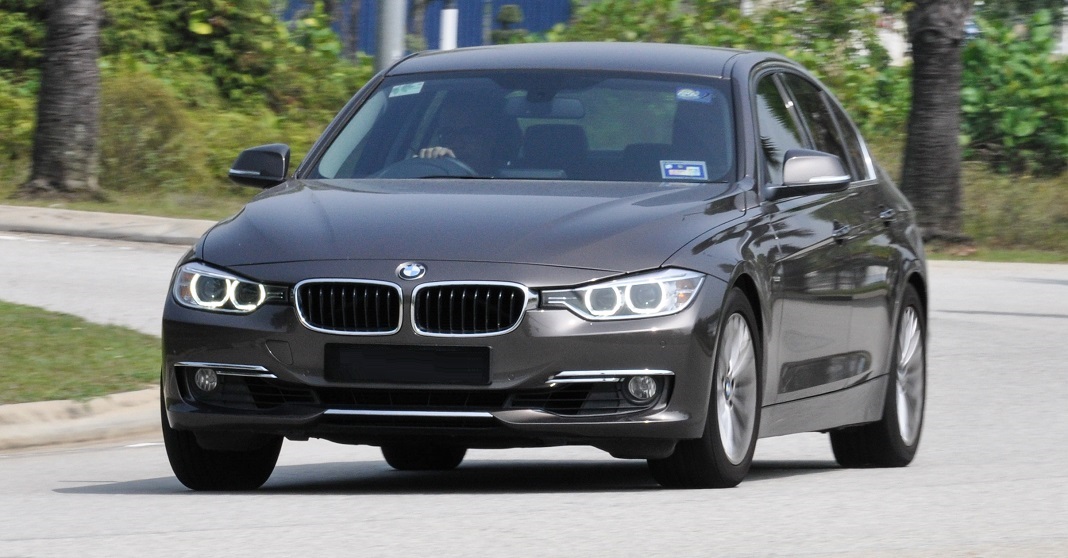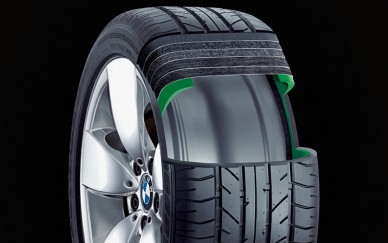 This is a question that continues to bug BMW owners when time is ripe to replace the worn set of RFTs (Run-Flat Tyres) that came with the car. Do you stick with them, or try regular tyres? It was a question this writer had to ponder over recently as the rubber on the family runabout (an F30 320i) nudged the 40,000km mark.
This is a question that continues to bug BMW owners when time is ripe to replace the worn set of RFTs (Run-Flat Tyres) that came with the car. Do you stick with them, or try regular tyres? It was a question this writer had to ponder over recently as the rubber on the family runabout (an F30 320i) nudged the 40,000km mark.
RFT background
BMW did not invent RFTs, but they are the first manufacturer that applied them across the entire range (except for the M cars) since the mid-2000s, and with good reasons too. Hailed as “tyres with their own spares”, RFTs have reinforced sidewalls so that they can be driven on even when there’s a leak or puncture, for at least 150km at speeds up to 80km/h – ample range with which to get the offending tyre fixed or replaced. In theory, with RFTs fitted to your car, you should never be left stranded or having to wait for road service due to punctures.
As RFTs are of a robust construction by design, it can be a lifesaver too during high-speed tyre blow outs by offering a higher degree of control over a normal tyre that would’ve suffered near instantaneous deflation. For the manufacturer, not having a spare tyre also means tangible weight savings (no spare tyre and related tools required) and added flexibility in terms of vehicle packaging, particularly boot space.
The unfortunate bad press
 RFT certainly courted its share of criticism over the years. Thicker tyre sidewalls that are able to support the weight of the vehicle come with a price – RFTs weigh more than normal tyres, they are also more rigid, with both factors having negative impact to ride comfort. That the implementation of RFTs coincided with a period when BMW cars were sprung more firmly relative to current generation models (e.g. the 3-Series of E90 against the F30) didn’t help matters, and many reviews soon attributed the lack of comfort squarely on RFTs, when it is in all fairness a much more complex issue than just the choice of rubber.
RFT certainly courted its share of criticism over the years. Thicker tyre sidewalls that are able to support the weight of the vehicle come with a price – RFTs weigh more than normal tyres, they are also more rigid, with both factors having negative impact to ride comfort. That the implementation of RFTs coincided with a period when BMW cars were sprung more firmly relative to current generation models (e.g. the 3-Series of E90 against the F30) didn’t help matters, and many reviews soon attributed the lack of comfort squarely on RFTs, when it is in all fairness a much more complex issue than just the choice of rubber.
There were also other concerns related to everyday use, namely what happens when a run-flat tyre picks up a nail, can it be fixed or patched up like a normal tyre? In those early years, the safe course of action (as recommended by both tyre brands and BMW) was to replace the tyre, after all, why risk another class-action of Firestone-Ford Explorer proportions? And since so few tyre brands offered RFTs, its availability and cost of replacement – almost twice the price of a standard tyre of the same size – troubled many owners.
Some years on…
One could say that RFTs have come a long way as more manufacturers adopt them as standard equipment, including BMW’s arch-rival Mercedes-Benz (there are already fitted on the MFA compact models such as the A, B, GLA, CLA and the C- and S-Class). Tyre makers have also been making steady strides in improving comfort and overall refinement of RFTs, so much so that it’s rare these days to find a BMW review that attributes RFTs as the main cause of discontent. That said, costs and availability (in terms of choices) remain as key concerns, but since more car brands are switching to RFTs, the situation can only improve.
The real world report
 Life with the set of Bridgestone Potenza S001 RFTs that clocked 40,000km wasn’t particularly eventful, though not without incidents. Over two and half years, three punctures (mainly nails) were patched up soon after low tyre pressure warnings came on, but on the fourth occasion, a rear tyre caught a large screw that somehow managed to lodge itself at the very edge of where the tread began, millimeters from where the sidewall ended. As the problem could only be attended to a day later (it was on a school run), the penetrated area started to spread, developing into a crack that meant a patch was no longer able to seal the tyre, which in turn necessitated a replacement tyre.
Life with the set of Bridgestone Potenza S001 RFTs that clocked 40,000km wasn’t particularly eventful, though not without incidents. Over two and half years, three punctures (mainly nails) were patched up soon after low tyre pressure warnings came on, but on the fourth occasion, a rear tyre caught a large screw that somehow managed to lodge itself at the very edge of where the tread began, millimeters from where the sidewall ended. As the problem could only be attended to a day later (it was on a school run), the penetrated area started to spread, developing into a crack that meant a patch was no longer able to seal the tyre, which in turn necessitated a replacement tyre.
Whether the crack was due to the tyre being an RFT wasn’t conclusive, a regular, non-RFT tyre could have suffered the same kind of damage (near the sidewall) and be rendered irreparable. More importantly, the RFT did its job by not leaving any occupants stranded by the road.
What’s life without compromises
Despite suffering a few punctures, I opted to replace the RFTs with regular tyres. There were a couple of factors. Firstly, I had managed to strike a hard-to-resist deal for a set of highly-rated Continental ContiSportContact 5 (there were no freebies in this story by the way) which I was eager to try, the fact that I couldn’t source its run-flat equivalent contributed as well. Furthermore, the other brands of RFTs were at least 30% more expensive (street price), and I didn’t fancy them either. In the end, the itch to find out if the 320i would perform any differently with regular tyres proved hard to resist.
On standard suspension with RFTs, the F30-generation 3-Series already strikes a fine compromise between comfort and fun for everyday use, though sharp road creases and poorly repaired asphalt can expose a knobbly edge. Rolling on aged or coarse tarmac, the Potenza S001 also has the tendency to make itself heard, more than what’s expected of a luxury saloon. The Continentals resolved most of that, it’s simply better at cushioning annoying road imperfections and being less susceptible to surface changes, allowing power to be laid down more cleanly, especially over uneven or slippery patches. So yes, the F30 now rides more pliantly than before, with improved overall composure.
There are some trade-offs however, the steering response isn’t quite as sharp nor as lively as the Bridgestone’s, and right off the bat, there was a touch more mid-corner roll which isn’t untypical when moving on to tyres with softer construction. In abating that, the Continentals were administered slightly higher pressures, around 1 to 2psi above the factory recommendation, to sharpen the turn-in. And after clocking more than 3,000km on them, can’t say I miss the RFTs.
To RFT or not
 This account is by no means an endorsement of regular tyres over RFTs. As the tyres mentioned above are of different construction and make, there would naturally be subjective differences, some of which might or might not necessarily matter to the larger population of BMW owners. So for anyone pondering over the same question – whether to go normal or stick with run-flat tyres – you have to weigh the pros and cons carefully because it’ll only take an errant nail or a notorious pothole (and there are many) to make you regret not sticking with run-flats. But if you do explore the alternate option, make sure you pay particular attention to the tyre pressure monitor and have a repair kit stashed in the trunk.
This account is by no means an endorsement of regular tyres over RFTs. As the tyres mentioned above are of different construction and make, there would naturally be subjective differences, some of which might or might not necessarily matter to the larger population of BMW owners. So for anyone pondering over the same question – whether to go normal or stick with run-flat tyres – you have to weigh the pros and cons carefully because it’ll only take an errant nail or a notorious pothole (and there are many) to make you regret not sticking with run-flats. But if you do explore the alternate option, make sure you pay particular attention to the tyre pressure monitor and have a repair kit stashed in the trunk.


